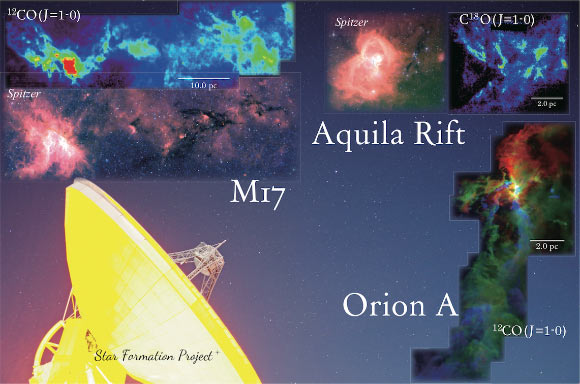Astronomers Map Out Three Nearby Molecular Clouds | Astronomy – Sci-News.com
Astronomers using the Nobeyama 45-m Radio Telescope in Japan have carried out mapping observations toward three nearby molecular clouds: Orion A, Aquila Rift, and Messier 17 (M17).

CO molecule radio emission-line intensities in Orion A, Aquila Rift, and Messeir 17 observed by the Star Formation Project and the Nobeyama 45-m Radio Telescope. Image credit: NAOJ.
“We know that stars such as the Sun are born from interstellar gas clouds,” said Dr. Fumitaka Nakamura, an astronomer at the National Astronomical Observatory of Japan (NAOJ), and colleagues.
“These interstellar gas clouds are difficult to observe in visible light, but emit strong radio wavelength.”
Dr. Nakamura’s team used the FOREST instrument, a new 100 GHz receiver on the Nobeyama telescope, to create detailed radio maps of Orion A, Aquila Rift, and M17.
These targets are located approximately 1,350, 1,422 and 6,849 light-years away, respectively.
The astronomers demonstrated that their data have enough capability to identify molecular outflows within the clouds.
For example, they identified four new outflow candidates within the Aquila Rift.
“For the Orion A region, we collaborated with the CARMA interferometer in the United States, combining their data to create the most detailed map ever of the region,” they said.
“The map has a spatial resolution of about 3,200 AU. This means that it can reveal details as small as 60 times the size of the Solar System.”
“Even the world’s most powerful radio telescope, the Atacama Large Millimeter/submillimeter Array (ALMA), could not obtain a similar large-scale map of Orion A because of ALMA’s limited field-of-view and observation time constraints.”
“But ALMA can investigate more distant interstellar clouds. Therefore, this large-scale, most-detailed radio map of the Orion A gas cloud obtained by the Star Formation Project is complementary with other observational research.”
Their results appear in the Publications of the Astronomical Society of Japan.
_____
Fumitaka Nakamura et al. 2019. Nobeyama 45 m mapping observations toward the nearby molecular clouds Orion A, Aquila Rift, and M17: Project overview. Publications of the Astronomical Society of Japan 71, issue supplement_1, S3; doi: 10.1093/pasj/psz057




